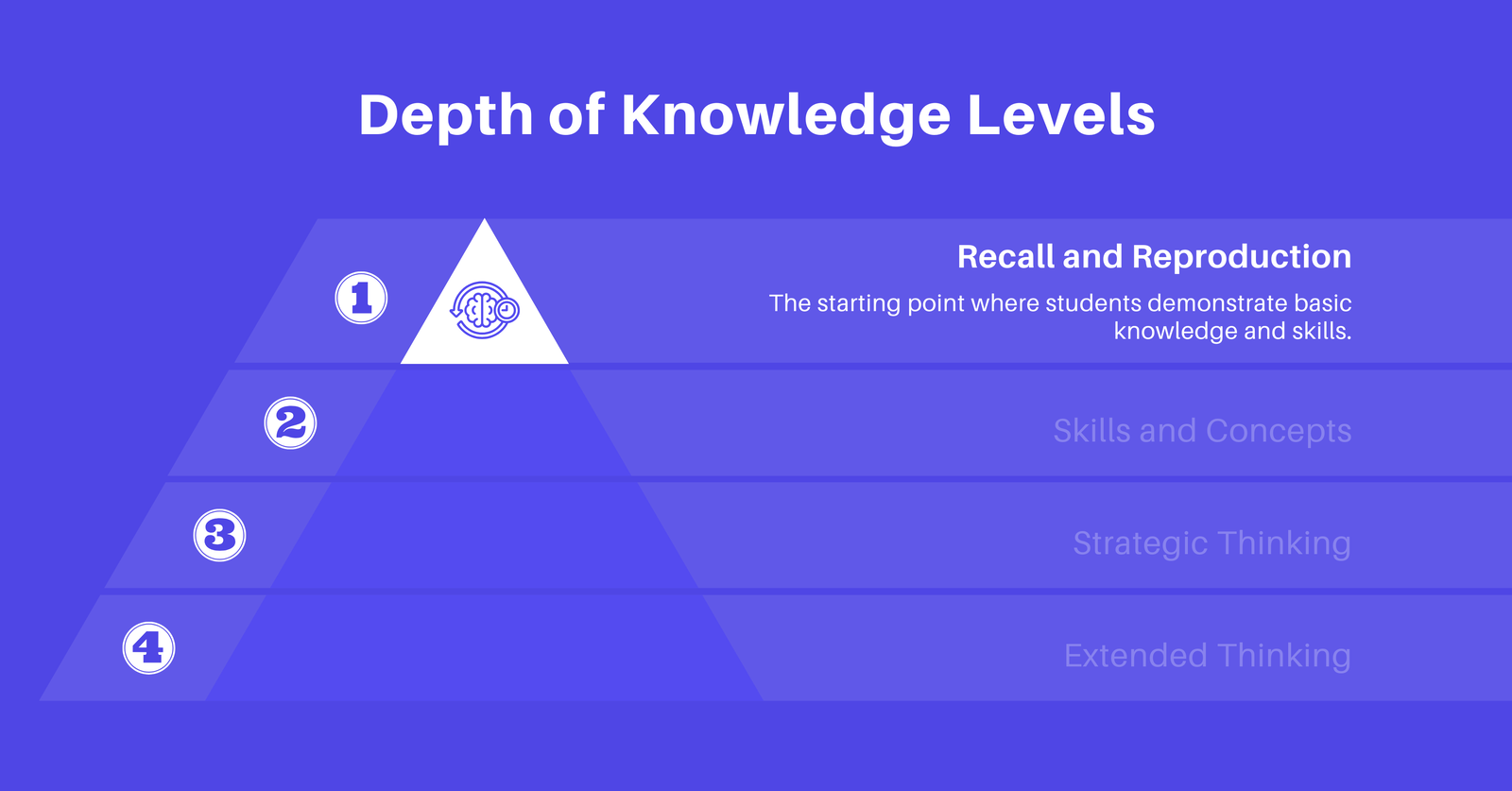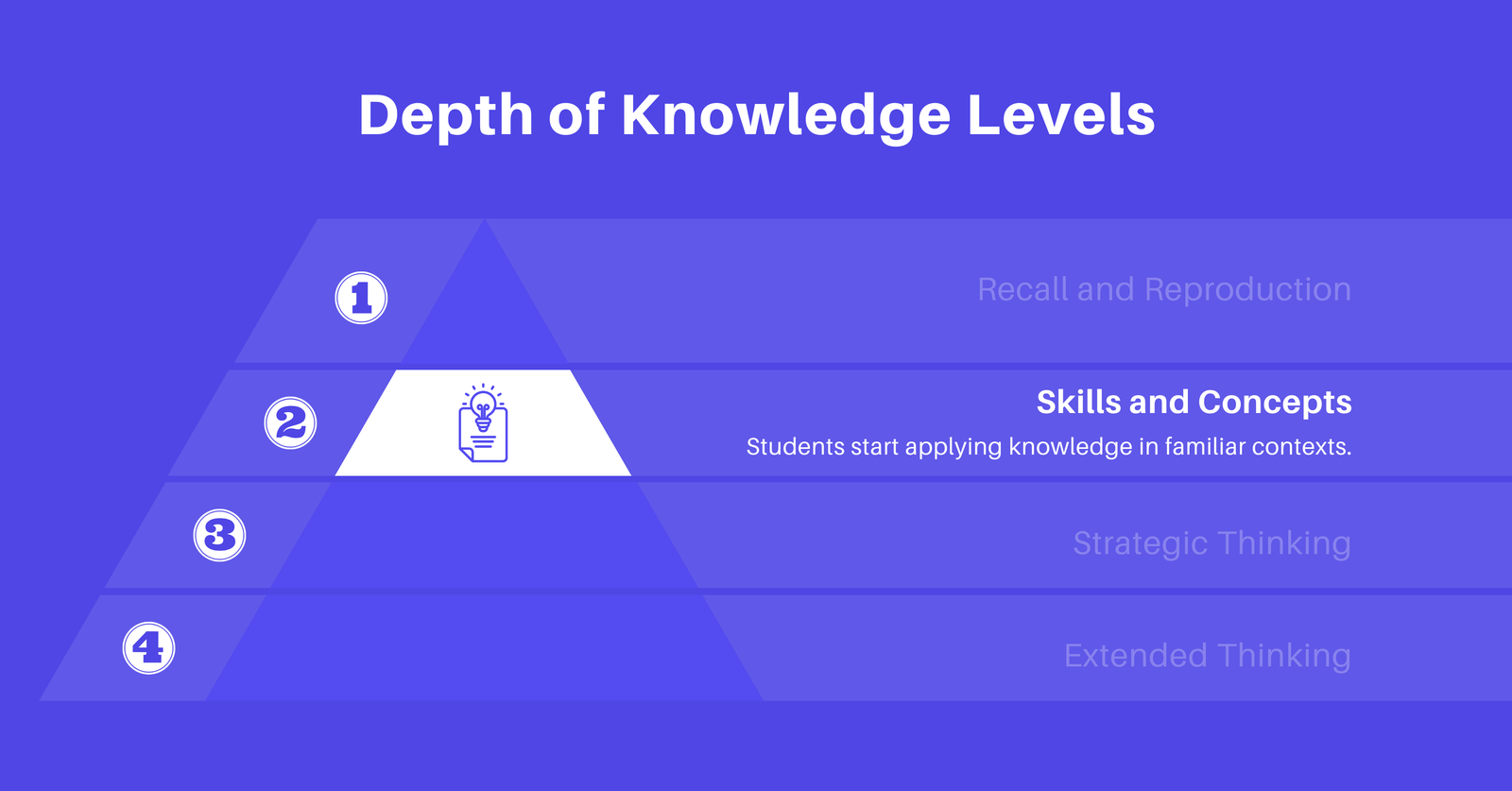Teaching is full of frameworks. A new one comes along, we learn about it, and then we do our best to bring it into the classroom. Sometimes it becomes mainstay. Other times, it just doesn’t.
Depth of Knowledge (DOK) often lands somewhere in between.
Some teachers hear “DOK” and immediately think of Bloom’s Taxonomy or worse, they picture that infamous DOK wheel and assume it’s all about assigning levels to questions, which Dr. Webb himself does not endorse.
But what DOK really targets is the sweet spot between rigor and engagement, and that’s something every teacher needs.
In this blog, we’ll unpack what Depth of Knowledge truly is, why it matters, and (most importantly) how you can use it to transform your teaching without adding unnecessary stress to your already-packed day.
What Makes DOK Different?
Let’s clear something up right away. Depth of Knowledge (DOK) is not another version of Bloom’s Taxonomy, nor it is some fancy new way to categorize questions.
One of the biggest misconceptions about DOK is that it’s interchangeable with Bloom’s. While both frameworks deal with levels of thinking, they serve different purposes:
- Bloom’s Taxonomy focuses on types of thinking: remembering, understanding, analyzing, creating. It’s hierarchical, with higher-order thinking at the top.
- DOK, on the other hand, simply measures the depth of cognitive effort required for a task.
Another common pitfall? The infamous DOK wheel. While it’s a helpful visual, it often leads teachers to focus on labeling tasks with numbers (Level 1, Level 2, etc.) without understanding why those levels matter.
So, if DOK isn’t about hierarchy or forcing every lesson into Levels 3 and 4, what is it?
At its core, Depth of Knowledge is a framework that helps teachers design tasks with the right level of cognitive demand. It breaks tasks down into four levels, each representing a different depth of thinking:
Level 1: Recall and Reproduction

If you’ve ever asked students to simply define a term, then you’ve already used Level 1 of Depth of Knowledge.
This is the foundation of Depth of Knowledge. The starting point where students demonstrate basic knowledge and skills. Remembering facts, or definitions, without much reasoning or analysis is what makes this level the framework’s beginning line.
But Level 1 often gets a bad rap. Some teachers assume it’s “too easy” or not worth spending time on because it doesn’t involve higher-order thinking.
Let’s set the record straight.
What Does Level 1 Look Like?
At its core, Level 1 tasks are straightforward. They involve recalling information or performing simple, routine procedures. Examples include:
- Math: Memorizing multiplication tables or solving basic addition problems.
- Science: Listing the steps of the scientific method or naming the parts of a cell.
- ELA: Identifying the main character in a story or defining vocabulary words.
- Social Studies: Recalling the year a historical event occurred or naming the branches of government.
More on our rundown on 6 Effective Retrieval Practice Strategies For Students’ Long-Term Success to support recall.
These tasks don’t require deep reasoning or problem-solving, but they’re essential. Without a solid foundation of knowledge, students can’t move on to more complex thinking at Levels 2, 3, or 4.
Testing recall can be made engaging when you turn question stems into interactive quizzes. For heavy PowerPoint users, consider adding ClassPoint to your PowerPoint. More on how you can run your first interactive PowerPoint quiz here.
Level 2: Skills and Concepts

If Level 1 is about building foundational knowledge, Level 2 is where students start applying that knowledge in familiar contexts.
At this level, tasks require skills, and some reasoning. Here, you start to ask students to apply concepts (more than just understanding them) to solve straightforward problems.
Think of Level 2 as the bridge between basic understanding (Level 1) and deeper, more complex thinking (Levels 3 and 4). It’s where students take what they’ve learned and use it in meaningful ways, but within structured parameters.
What Does Level 2 Look Like?
Level 2 tasks often involve application and organization of knowledge. They’re more challenging than Level 1 but still predictable and guided. Examples include:
- Math: Solving a word problem that requires one or two steps (e.g., “If Sarah buys 3 books for $5 each, how much does she spend?”).
Here's a list of 150 Challenging Math Word Problems with Solutions Across Different Categories for Students from K to Grade 8 to help spark inspiration.
- Science: Classifying animals into groups based on shared characteristics or predicting the outcome of an experiment.
- ELA: Summarizing the main idea of a passage or comparing two characters in a story.
- Social Studies: Explaining the causes of a historical event or interpreting a map to answer questions about geography.
These tasks ask students to do something with the information they’ve learned, but in ways that are still fairly routine and scaffolded.
Talking about scaffolding, here are 8 Ideas To Master Scaffolding in Education And Boost Learning.
Level 3: Strategic Thinking

If Level 2 is about applying knowledge in familiar contexts, Level 3 takes it further by requiring students to solve non-routine problems, and justify their reasoning.
At this level, tasks demand higher-order thinking skills: analyzing patterns, drawing conclusions, evaluating evidence, and explaining why something works (or doesn’t). These often involve multiple steps and require students to make decisions along the way.
Check out how you can enhance students' higher-order thinking skills with AI integration.
In short, Level 3 is where learning becomes challenging, but also deeply rewarding.
What Does Level 3 Look Like?
Level 3 tasks push students to go beyond simple application. They involve using evidence to support their thinking. Examples include:
- Math: Solving a multi-step word problem that requires students to decide which operations to use and explain their process.
- Science: Designing an experiment to test a hypothesis or analyzing data to identify trends and draw conclusions.
- ELA: Writing an argumentative essay that uses textual evidence to support claims or comparing themes across multiple texts.
- Social Studies: Evaluating the impact of a historical event on modern society or debating the pros and cons of a policy decision.
When students take on more complex tasks, it's important to reward them. When delivering lessons in PowerPoint with ClassPoint, easily incorporate a full gamified reward system that's sure to boost motivation and promote healthy competition in the classroom.
Level 4: Extended Thinking

If Level 3 is about reasoning and problem-solving, Level 4 takes it to the next level. Literally.
At this stage, tasks are multifaceted, and often long-term. They require students to synthesize information from multiple sources, and produce work that demonstrates deep understanding. These tasks are open-ended, meaning there’s no single “right answer,” and they often involve real-world applications or interdisciplinary connections.
Point blank: Level 4 is where learning becomes transformative.
What Does Level 4 Look Like?
Level 4 tasks are all about extended effort. They go beyond what can be accomplished in a single lesson or day. Examples include:
- Math: Designing a blueprint for a community garden that maximizes space while meeting specific criteria (e.g., budget, accessibility).
- Science: Conducting an extended investigation into local water quality, analyzing data, and proposing solutions to address pollution.
- ELA: Writing and publishing a short story, script, or research paper that incorporates feedback from peers and multiple drafts.
- Social Studies: Creating a detailed plan to address a global issue like climate change or poverty, complete with research, cost analysis, and policy recommendations.
Level 4 tasks may also include a debate that further taps into students' long-term view on important real-world matters. For inspiration, here are 70 Thought-Provoking Debate Topics for Students in Different Categories That Cover the Most Important Issues of Our Time.
Aligning DOK with State Standards and Classroom Realities
By understanding how DOK aligns with state standards and assessment requirements, you can design lessons that are both rigorous and relevant. Let’s break it down.
1. DOK and State Standards
State standards define how deeply students are expected to engage with the content. And that’s where DOK can be a helpful tie-in.
Most standards explicitly require students to demonstrate thinking at multiple DOK levels:
- Level 1: Foundational skills, like recalling math facts or identifying key details in a text, are often embedded in early-grade standards.
- Levels 2 and 3: Application and reasoning tasks, such as analyzing texts, solving multi-step problems, or designing experiments, are frequently part of middle- and upper-grade expectations.
- Level 4: Extended tasks, like research projects or problem-based learning units, align with cumulative or capstone standards that require synthesis and sustained effort.
When you map your lessons to DOK levels, you’re ensuring that your teaching directly supports the cognitive demands of your state standards.
Pro Tip: When unpacking your standards, look for verbs like analyze, evaluate, design, or synthesize. They often signal higher DOK levels and can guide your lesson planning.
2. Preparing for Standardized Tests
Standardized tests are a reality for most teachers. While they may not be your favorite part of the job, they’re an important measure of student achievement, and they’re often tied to accountability systems.
Most standardized tests are built around DOK levels. Questions range from basic recall (Level 1) to multi-step reasoning (Levels 2 and 3).
Do not resort to to “drill-and-kill” tactics.
- Instead of drilling vocabulary definitions (Level 1), ask students to explain how an author uses word choice to convey tone (Level 3).
- Instead of practicing isolated math facts (Level 1), have students solve real-world problems that require multiple steps and reasoning (Level 2 or 3).
3. Deconstructing DOK
One of the most powerful ways to use DOK is as a lesson-planning filter. Here’s how you can deconstruct it to align with your curriculum and state standards:
- Start with the Standard: Identify the cognitive demand of the standard. Is it asking students to recall information, apply concepts, or analyze relationships?
- Map It to DOK Levels: Decide which level(s) the standard targets. Some standards may span multiple levels—for example, a science standard might require students to conduct an experiment (Level 3) and then write a report summarizing findings (Level 2).
- Design Tasks Accordingly: Create activities that match the DOK level(s) of the standard. For example:
- A Level 2 task might involve categorizing evidence from a text.
- A Level 3 task could ask students to evaluate the reliability of sources.
- A Level 4 task might involve designing a public service announcement based on their analysis.
4. Advocating for DOK in Your School or District
Finally, don’t underestimate the power of DOK as a common language for discussing rigor and engagement with colleagues, administrators, and even parents.
In many schools, there’s a disconnect between what teachers are expected to do (teach to the standards) and how they’re supported (generic PD or vague directives about “rigor”). By introducing DOK as a shared framework, you can:
- Help colleagues plan lessons that align with state standards.
- Advocate for professional development that focuses on intentional task design.
- Push back against initiatives that prioritize busywork over meaningful learning.
